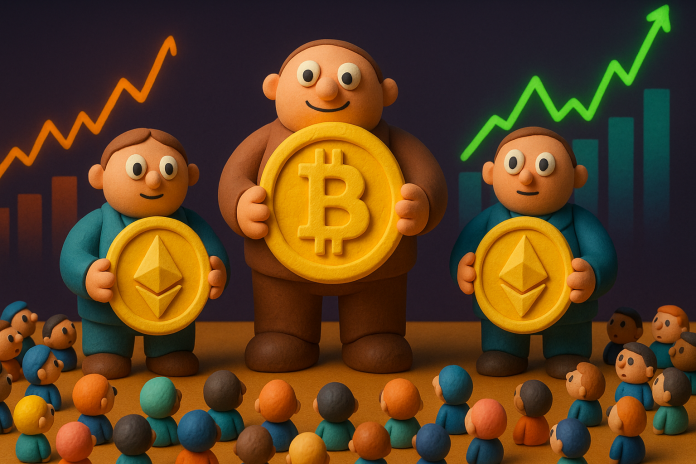
South Korea’s cryptocurrency market is increasingly consolidating around a small group of investors. According to recent data released by lawmaker Lee Heon-seung of the National Assembly’s Political Affairs Committee, citing figures from the Financial Supervisory Service (FSS), the top 10% of investors accounted for 91.2% of total trading volume across the nation’s five major exchanges — Upbit, Bithumb, Coinone, Korbit, and Gopax — from 2024 through June 2025.
The breakdown shows that high-net-worth investors dominate nearly all trading activity: about 88.7% at Upbit, 97.5% at Bithumb, 97.2% at Coinone, 97.9% at Korbit, and 99.2% at Gopax. In some cases, the concentration exceeds 95%, particularly in leading assets such as Bitcoin, XRP, and Ethereum, where large investors increasingly dictate market movements.
Analysts attribute this imbalance to the widening gap in capital and information access between institutional and retail traders. Wealthy investors benefit from faster systems, access to market intelligence, and algorithmic strategies that exploit short-term price swings. In contrast, smaller investors face higher trading fees, liquidity limitations, and uncertainty in volatile market conditions, which collectively reduce their level of participation.
Structural factors are also contributing to this polarization. Under Korea’s “real-name account” system, cryptocurrency exchanges must partner with licensed banks to process fiat transactions. This restriction tends to channel liquidity toward specific platforms while making it difficult for smaller players to diversify. The growing presence of institutional funds and high-capital entities in the market has further amplified their influence.
The concern, observers say, is that such concentration could undermine both the fairness and stability of the broader market. When a handful of investors control most trading volume, even a single large sell-off can trigger sharp price fluctuations. Recent market swings, some linked to large sell orders from major accounts, have reinforced worries over volatility and market manipulation.
Experts stress that both regulators and exchanges must take more active roles in addressing the imbalance. Measures such as greater transaction transparency, disclosure of high-volume investor ratios, and real-time monitoring of large trades are being discussed. In parallel, proposals to lower fees for smaller traders and enhance competition between exchanges are gaining attention as possible ways to restore balance.
The findings are viewed as a wake-up call for Korea’s maturing crypto industry. As digital assets become increasingly integrated into mainstream finance, structural inequality in trading activity poses a new challenge for investor protection and market soundness. “If the crypto market truly aims for decentralization,” one analyst said, “it must evolve toward fairer capital distribution. Without that shift, it risks becoming a playground for the few rather than an opportunity for the many.”





![[November]Uptober No More](https://coinhubkorea.com/wp-content/uploads/2025/10/Whisk_d78880efb01a730907f4be201effefe1dr-1-100x70.jpeg)
